
FORM acknowledges the Traditional Owners and Custodians throughout Western Australia both past and present, whose enduring connection to this Country and ongoing contributions to our collective culture and communities we respect and honour. We appreciate and are deeply grateful for the privilege of working on these lands.
2
Cover: Stacia Lewis, Kungkarangkalpa (Seven Sisters Dreaming) (detail), acrylic on canvas, 137 x 121 cm. Image courtesy of Minyma Kutjara Art Project.
Maruku Arts
(Ngaanyatjarra Pitjantjatjara Yankunytjatjara Lands)
Minyma Kutjara Arts Project
(Irrunytju/Wingellina, Western Australia)
Papulankutja Artists
(Papulankutja/Blackstone and Mantamaru/Jameson, Western Australia)
Tjanpi Desert Weavers
(Ngaanyatjarra Pitjantjatjara Yankunytjatjara Lands)
Tjarlirli Art
(Tjukurla, Western Australia)
Warakurna Artists
(Warakurna, Wanarn and Patjarr, Western Australia)
3
Really One Story: Art from the Ngaanyatjarra Lands
 Country near Tjukurla. Photograph courtesy of Tjarlirli Art.
Country near Tjukurla. Photograph courtesy of Tjarlirli Art.

6
Introduction
Really One Story: Art from the Ngaanyatjarra Lands showcases recent works from the six Aboriginal art centres of the Ngaanyatjarra communities in Western Australia’s far-east, one of the State’s most prolific artmaking regions over the past three decades. The exhibition comprises work by senior, mid-career and emerging artists from Minyma Kutjara Arts Project in Irrunytju (Wingellina); Papulankutja Artists in Papulanktuja (Blackstone and Mantamaru (Jameson); Tjarlirli Art in Tjukurla; Warakurna Artists in Warakurna, Wanarn and Patjarr; and the Tjanpi Desert Weavers and Maruku Arts initiatives that support practitioners based across the vast Ngaanyatjarra, Yankunytjatjara, and Pitjantjatjara Lands of central Australia. The exhibition presents a diverse collection of works on canvas, tjanpi (grass) sculptures, punu (woodcarvings) and video, inspired by the beautifully bold colours of the artists’ desert Ngurra (home, Country), by tales of Tjukurrpa (the foundation of Yarnangu life and society), and by reflections on contemporary life in remote communities.
The Naanyatjarra Lands occupy around 250,000 square kilometres of desert adjacent to Western Australia’s tri-state border with South Australia and the Northern Territory. As documented in John Carty’s history of Ngaanyatjarra artmaking1, painting came late to the Lands, with hand-crafted mediums dominating the communities from the early 1980s. Maruku Arts and Crafts was the region’s first commercial artistic enterprise, sustaining and promoting skills in punu that were already a well-established practice across central Australia, with the Ngaanyatjarra Pitjantjatjara Yankunytjatjara Women’s Council (NPYWC) supporting multiple disciplines of women’s art, leading to the foundation of the Tjanpi enterprise in 1995.
During the late 1970s and early 1980s, painting from Papunya Tula and other leading art centres in central Australia was beginning to find a global audience, and it was widely agreed (by the Federal Government’s Aboriginal Arts Board) that the Ngaanyatjarra Lands to the west would be better advised to focus on woodcraft as a point of difference, and to avoid saturating the fledgling market for Aboriginal painting. As a result, painting was not widely embraced by Ngaanyatjarra artists until the foundation of the Warburton Arts Project in 1990, and the region’s first art centre did not open until 1991 with the establishment of Irrunytju Arts. Even then, painting would take time to develop, with many artists today noting that their careers began with punu and tjanpi, and that they came to painting well after establishing their practices with these other mediums.2
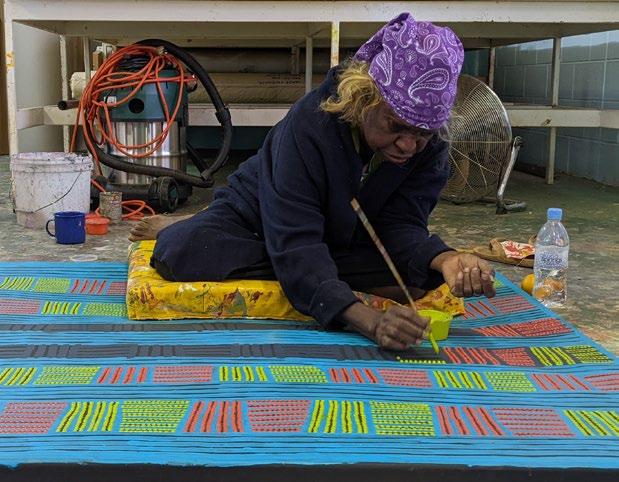
The remarkable Tjanpi Desert Weavers initiative grew from the efforts of the NPYWC during the preceding decade to support the women of the
1 Carty, J., ‘Purnu, tjanpi, canvas: a Ngaanyatjarra art history’ in Ngaanyatjarra: Art of the Lands, Acker, T. and Carty, J. Eds, UWA publishing, Crawley, Western Australia, 2012, pp. 15-33.
2 See for example Narelle Holland (ibid, p. 15) and Thelma McLean (ibid, p.17), Jean Inyalanka Bourke (ibid, p. 17).
7 Really One Story: Art from the Ngaanyatjarra Lands
Faith Butler painting at Tjarlirli Art, May 2022. Photograph courtesy of Tjarlirli Art.
NPY Lands. A number of mediums had already been trialled with limited success when arts worker Thisbe Purich introduced basket weaving at a Ngaanyatjarra women’s gathering in Papulankutja in 1995, inspired by a suggestion from iconic non-Indigenous textiles artist Nalda Searles, who had a strong relationship with the women of the eastern Goldfields. Though it initially took a few days to catch on, once established the medium would spread with remarkable rapidity and expertise, to encompass the majority of Aboriginal communities across the nation’s centre. Much like punu weaving tapped into millennia-old skills in utilising native fibre, while also providing rich opportunity for contemporary expression. Weaving had an immediate resonance with the rhythms of remote community life: it could be practised socially, while sitting around a campfire with dogs and children and the materials were inexpensive and easily transported when artists needed to travel for work, Law, and social or cultural purposes.
Though artmaking came later to Ngaanyatjarra artists, they are recognised today as some of the most imaginative and innovative practitioners working from central Australia, Carty noting that the region has produced “some of the greatest artists of the Western Desert”3 going on to state that “[w] here, in other regions of the desert, painting has become the principal artistic and economic strategy, the Ngaanyatjarra artists have maintained a diversity of practice that continues to invigorate their art.”4 Tjanpi in particular is renowned as a particularly exuberant medium, with artists
from Ngaanyatjarra communities widely recognised as the most passionate innovators of woven sculpture during the early days of the movement. This momentum culminated in the awarding of the 2005 National Aboriginal and Torres Strait Islander Art Award to the now-iconic Tjanpi Toyota, created by Kanytjupayi Benson and 19 other Ngaanyatjarra artists, one of only two Ngaanyatjarra works to take out the exhibition’s major prize, along with Papulankutja-based Ngaanyatjarra/Pitjantjatjara artist Mr. Donegan (dec), in 2010.
FORM has a long history of collaboration with the artists of the Ngaanyatjarra Lands, including their representation in the touring exhibitions Women’s Business Travelling: A Celebration of Women’s Work from Western Australia and KOLOA: What One Values, Pacific and Aboriginal Women’s Craft, both from 1995. A landmark project was Seven Sisters – Fibre Works Arising from the West curated for FORM by Kevin Murray to showcase the broad cross-cultural networks of fibre artists connected to Nalda Searles. The exhibition opened in Perth in 2003, before touring nationally. Its centrepiece was a commissioned series of life-sized Seven Sisters and their accompanying Wati Nyiru (larrikin man) by Tjanpi artists from Papalunkutja and Irrunytju in collaboration with Searles and Purich, a dramatic installation which would later feature in Songlines: Tracking the Seven Sisters, which opened at the National Museum of Australia in 2017 and is currently touring internationally.
Tjanpi weavers from Papulankutja, WA (Blackstone Community):
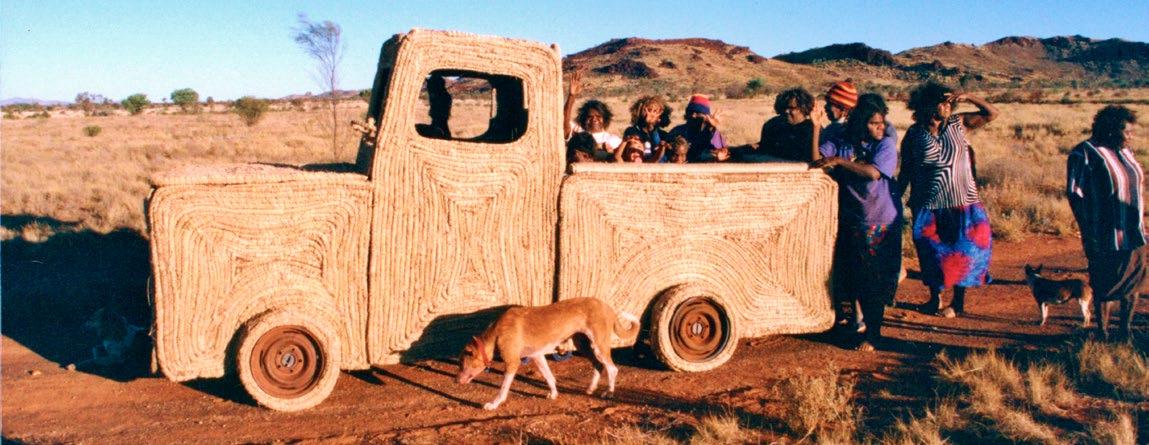
Kanytjupayi Benson (dec.), Shirley Bennet, Nuniwa Donegan (dec.), Margaret Donegan, Melissa Donegan, Janet Forbes, Ruby Forbes (dec.), Deidre Lane, Elaine Lane, Freda Lane, Janet Lane, Jean Lane, Wendy Lane, Angela Lyon, Sarkaway Lyon, Angkaliya Mitchell, Mary Smith, Gail Nelson. Tjanpi Toyota. 2005. Image by Thisbe Purich.
© Tjanpi Desert Weavers, NPY Women’s Council.
8
Ngaanyatjarra artists were regularly shortlisted for the Hedland Art Awards, managed by FORM at the Port Hedland Courthouse Gallery from 2009 to 2018, with a number of Warakurna-based artists taking out major awards for both paintings and tjanpi sculptures. Warakurna, Tjarlirli and Tjanpi artists also prominently featured in Flight – Aboriginal Perspectives from the Sky, curated by Dr. Darren Jorgensen and Mollie Hewitt for FORM in 2017, a project that related traditional and contemporary narratives of flight.
From 2016 to 2019 an experimental collaboration between Tjanpi Desert Weavers, FORM and Melbourne-based children’s theatre company Polyglot Theatre, Manguri Wiltja, saw a group of Tjanpi artists from Warakurna lead the creation of a hybrid participatory installation for children. Aimed at articulating the experience of remote desert life to metropolitan audiences,

the project culminated in a 2019 showcase at Revealed, at Fremantle Arts Centre, and the three partnering organisations hope to continue touring the project now that COVID travel restrictions have eased.
Following from these multifarious projects, Really One Story is FORM’s first survey showcase of Ngaanyatjarra artists at FORM Gallery, and we are excited to continue our ongoing collaboration with these extraordinarily diverse and adventurous artists, and introduce our audience to the remarkable creative practices of these Western Desert communities.
Andrew Nicholls
Senior Curator/Strategic Curatorial Lead, FORM
9
Really One Story: Art from the Ngaanyatjarra Lands
3 ibid, p. 15. 4 ibid, p. 33.
Papulankutja Artists on Country, 2022. Photograph by Beth Lewis, courtesy of Papulakutja Artists.

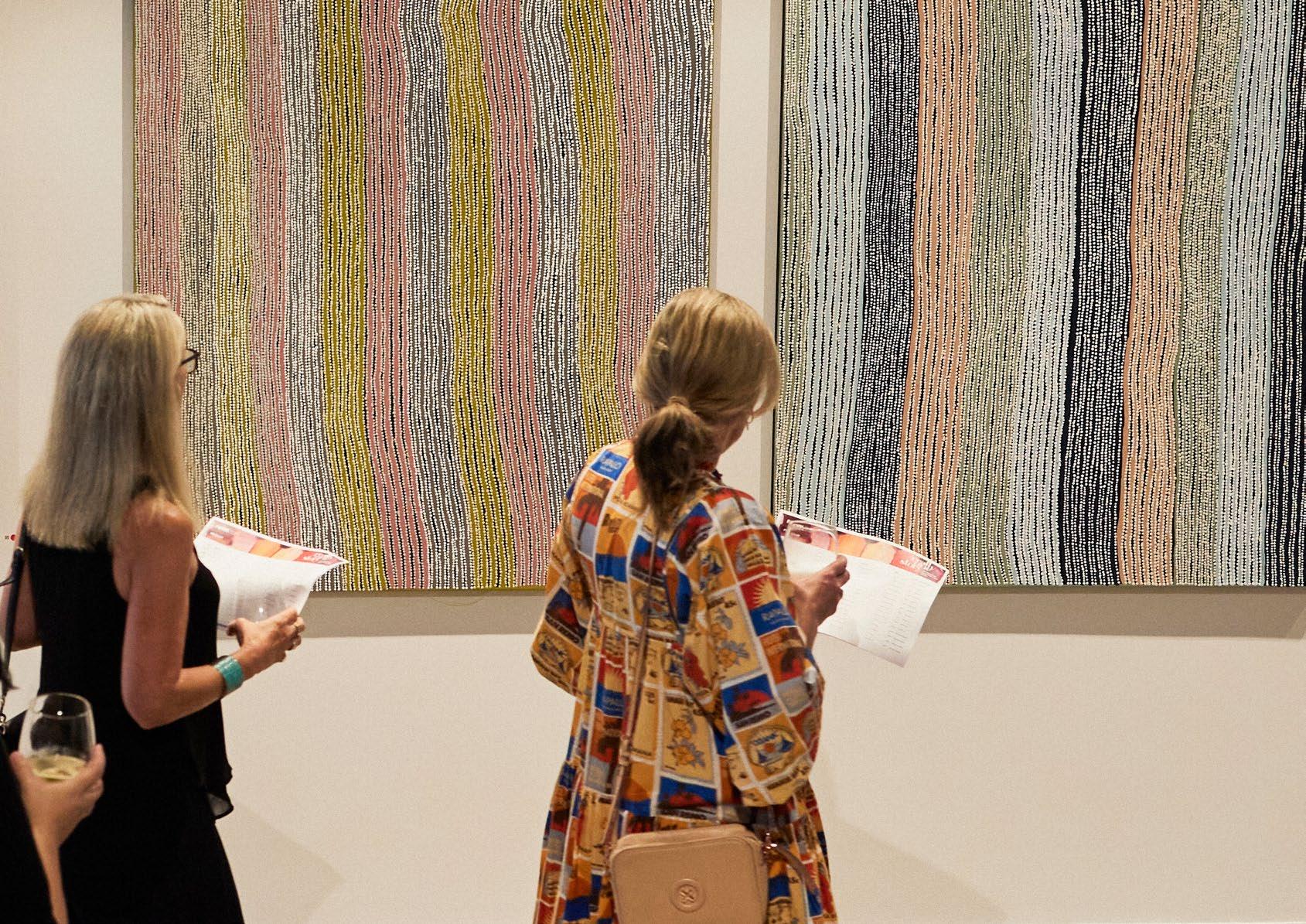 Really One Story exhibition opening, FORM Gallery, 2023. Photograph by Dan MacBride, courtesy of FORM.
Really One Story exhibition opening, FORM Gallery, 2023. Photograph by Dan MacBride, courtesy of FORM.
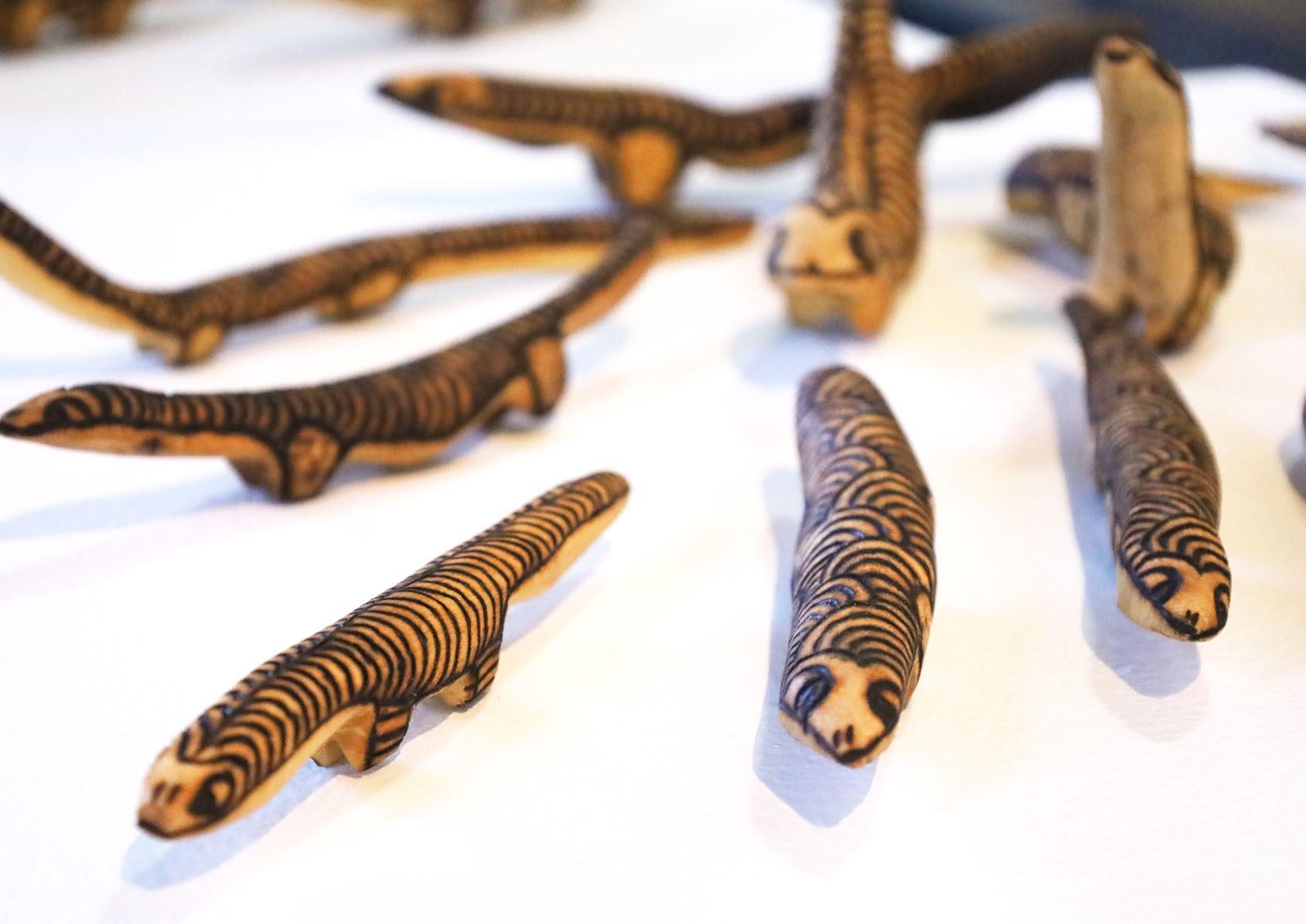 Tinkas by Cynthia Burke, 2022.
Photograph courtesy of Maraku Arts and FORM.
Tinkas by Cynthia Burke, 2022.
Photograph courtesy of Maraku Arts and FORM.
Maruku Arts
“I’ve been cutting and carving wood now for a very long time and over the years I have gotten better at what I love doing. It is a tradition that has been passed down from generation to generation in my family to this very point where we are right now…
I love making punu. The pattern and texture in the wood is just what I love about Mulga trees.”
Artist Brett Jennings
Maruku literally means ‘belonging to black’ in Pitjantjatjara language. This is because Maruku is owned and operated by Anangu (Aboriginal people from the Western and Central Deserts of Australia), with approximately 900 artists currently making up the collective.
Established in 1984, Maruku is among the earliest Aboriginal collectives supporting artists across the central and western desert regions. For more than three decades Maruku has kept Anangu culture strong and alive for future generations, while sharing it in an authentic way for audiences and collectors, and generating income for artists living in remote communities.
Currently, Maruku comprises a warehouse based in Mutitjulu community, and a retail gallery at Uluru-Kata Tjuta National Park Cultural Centre. In addition to selling paintings and punu (wooden carvings) Maruku offers tours, workshops, demonstrations, traditional ceremonies and exhibitions.
Lily Bates
Cynthia Burke
Nancy Carnegie
Lena Dawson
Sally Anne Foster
Dianne Golding
Narelle Holland
Brett Jennings
Ian Rictor
Lynette Smith
Dianne Strangways
Debra West
13 Really One Story: Art from the Ngaanyatjarra Lands
NGAANYATJARRA PITJANTJATJARA YANKUNYTJATJARA LANDS
Ian Rictor
Tjara (Shield), 2019
Kataya (limestone wattle)
63 x 7 x 4.8 cm
EX-ROS-C066E25
“Tjara atuni, wanari atura tjuni atukatara wiyaringkula tjana alani, mara tjarpantjaku. Ka palunya runkantjikitjangku pikangka runkani ka anga tjunanyi. Kuranilta ngulungku paluru ila mulapa runkani ka wii, tjilkali, tjilkali anu untura waninyi pungkula waninyi, pungkula waninyi. Kutjarangku pulangku kutitji tjara palyangku, ngalkilpai patjuri wiya panya.”
Wati Tjilpi
“The shield is cut from mulga wood, the front is cut, chopped and cut and when that’s finished an opening is made in the other side for your hand. In a fight when being attacked, it is used to block blows. A ferocious fighter attacks from close up and look out, you’re dodging and deflecting the strikes whizzing past you. Two men will use shields like this to save themselves from being hurt.”
Senior Anangu Man
Brett Jennings
Miru (Spearthrower), 2020
Wanari-Mulga Wood, Kiti - spinifex resin, pulyku - sinew
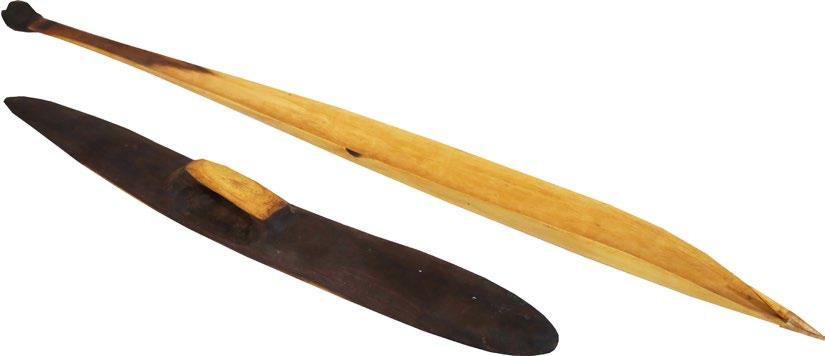
98 x 6.7 x 8.5 cm
EX-ROS-C081H5
“I have always listened, looked and learned from the old people. That’s really important to have respect for them. I love making punu. The pattern and texture in the wood is just what I love about Mulga trees (Acacia Aneura). Doing the final touch in the boomerang or shield is so nice I really love it.”
Artist Brett Jennings
14 Maruku Arts


15 Really One
from the Ngaanyatjarra Lands
Story: Art
Cynthia Burke Ngura - Country, 2022 Burnt etching on plywood 58 x 58.5 cm
EX-ROS-WB974
Dianne Golding Kungkarangkalpa - Seven Sisters, 2022 Burnt etching on plywood 60 x 90 cm
EX-ROS-WB973
Piti
Muur-Muurpa - Desert Bloodwood
47 x 24 x 16.5 cm
EX-ROS-L636H2
Kanilpa - Winnowing
Itara - river red gum
45 x 17.5 x 9.5 cm
EX-ROS-L638R1
Piti - Collecting Bowl, 2022
Muur-Muurpa - Desert Bloodwood



74 x 40 x 13.2 cm
EX-ROS-L633N1
16 Maruku Arts
Cynthia Burke
Bowl, 2022
Lena Dawson
Cynthia Burke
- Collecting Bowl, 2022
Piti - Collecting Bowl, 2022
Itara - river red gum
50 x 12.5 x 7 cm
Piti - Collecting Bowl, 2022


Itara - river red gum
59.5 x 19.5 x 10.2 cm
EX-ROS-C049H7
17 Really One Story: Art from the Ngaanyatjarra Lands
Narelle Holland
Nancy Carnegie
EX-ROS-C055F1
Debra West
Wana - Digging Stick, 2022
Wanari-Mulga Wood, 127 cm
EX-ROS-C062S1
Unknown
Wana - Digging Stick, 2022
Wanari-Mulga Wood, 88 cm
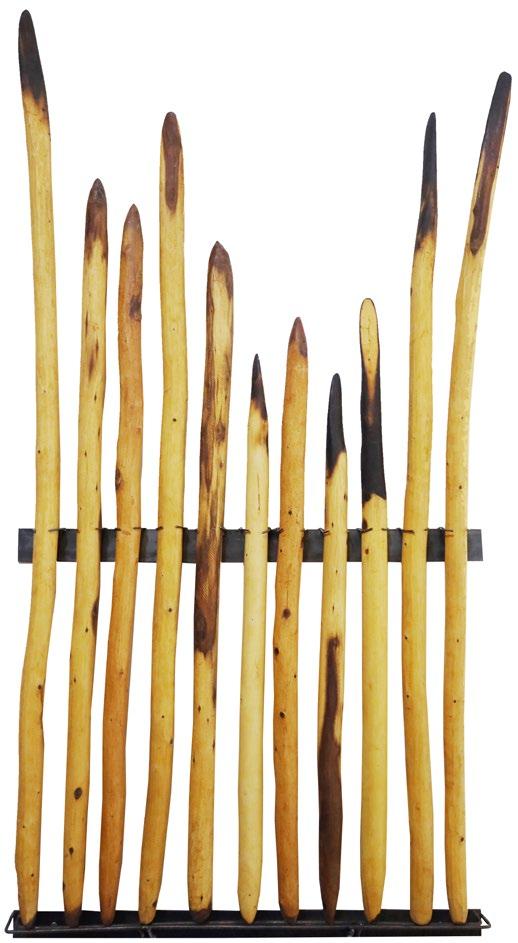
EX-ROS-DSCJ-2
Unknown
Wana - Digging Stick, 2022
Wanari-Mulga Wood, 108 cm
EX-ROS-DSCE
Sally Anne Foster
Wana - Digging Stick, 2022
Wanari-Mulga Wood, 62.5cm
EX-ROS-L640E2
Unknown
Wana - Digging Stick, 2022
Wanari-Mulga Wood, 104 cm
EX-ROS-DSDE
Wana - Digging Stick, 2022
Wanari-Mulga Wood, 80 cm
EX-ROS-L640E1
Debra West
Wana - Digging Stick, 2022
Wanari-Mulga Wood, 119 cm
EX-ROS-C062S3
Lynette Smith
Wana - Digging Stick, 2022
Wanari-Mulga Wood, 121 cm
EX-ROS-C062T1
Unknown
Wana - Digging Stick, 2022
Wanari-Mulga Wood, 100 cm
EX-ROS-DSCJ-1
Debra West
Wana - Digging Stick, 2022
Wanari-Mulga Wood, 120.5 cm
EX-ROS-C062S2
18 Maruku Arts
Sally Anne Foster
Wana - Digging Stick, 2022
Wanari-Mulga Wood, 90 cm
1 7 8 9 10 11 2 3 4 5 6
EX-ROS-L641Q1
Sally Anne Foster
2 1 3 4 5 6 7 8 9 10 11



19 Really One Story: Art from the Ngaanyatjarra Lands
Cynthia Burke Titles, materials and dimensions vary
B James Kuniya, 2022 47 x 35 x 13 cm EX-ROS-ANFJ-1
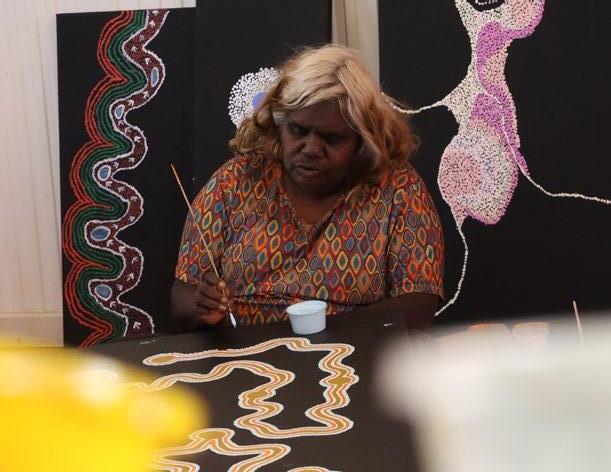

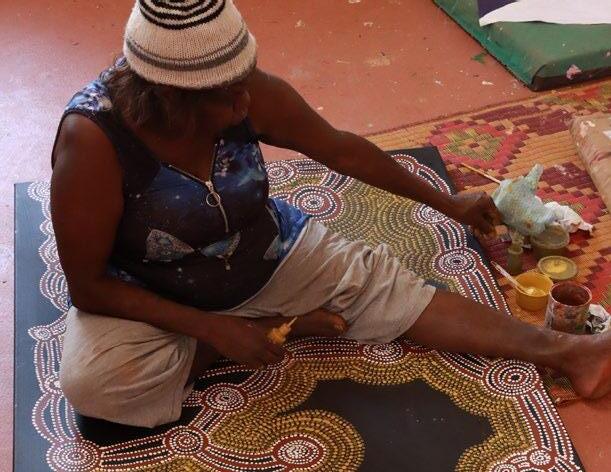

20 Minyma Kutjara
Heather Watson in the studio, 2022. Photograph courtesy of Minyma Kutjara Arts Project.
Stacia Lewis in the studio, 2022. Photograph courtesy of Minyma Kutjara Arts Project.
Diane Dawson in the studio, 2022. Photograph courtesy of Minyma Kutjara Arts Project.
Noreen Parker in the studio, 2022. Photograph courtesy of Minyma Kutjara Arts Project.
IRRUNYTJU/WINGELLINA, WESTERN AUSTRALIA
Minyma Kutjara Arts Project
“Walka Wiru Ngura Wiru [lovely country, lovely drawing]” Artist Alison Watson
Minyma Kutjara Arts Project is a not-forprofit community-based enterprise run by and representing artists from the remote community of Irrunytju (Wingellina) in Western Australia, 10 kilometres from the tri-state border of the Northern Territory and South Australia. Drawing on an intergenerational history of law, culture and unbroken stories, the studio provides a space to safeguard cultural heritage through artistic expression. It is a space for the production of individual and collaborative works, and a meeting place to learn, explore and share culture,
supporting a variety of creative activities including painting, metal work, punu (wooden carvings), tjanpi (grass) weaving, hot poker seed work and the production of bush medicine.
Minyma Kutjara tjukurpa (Two Women creation story) is an important dreaming from the western and southern deserts which tells the story of two sisters’ epic journey as they travel home across the Lands. Through sacred inma (storytelling, song and dance), their actions create sacred landmarks, such as rock holes and mountain ranges, embedded with important women’s business and ceremony. Irrunytju community sits at the base of a Minyma Kutjara site called Ultiju Kapi (Two Hills).
Lloyd Ajax
Diane Dawson
Stacia Yvonne Lewis
Noreen Parker
Alison Watson
Cyril Watson
Heather Watson
21 Really One Story: Art from the Ngaanyatjarra Lands
Alison Watson carries the Minyma Kutjara (two sisters story) Tjukurrpa (story); one of the most important women’s creation stories of the western and southern deserts and a special story for Irrunytju. It tells the story of the difficult journey of two sisters who travelled throughout these vast lands. The story is one that has been told many times through dance and painting.
The places where the sisters travelled and rested can be traced through the desert, their actions often created landmarks, rock-holes and mountain ranges. Near Irrunytju the sisters sat on two hills and made hair belts in preparation for important women’s business. Here they threw their wana (digging stick) creating Wana Wani rockhole.

22 Minyma Kutjara
Wati Tjilpi
Text courtesy of Minyma Kutjara Arts Project.
Alison Watson
Walka Wiru Ngura Wiru, 2022
Acrylic on canvas 91 x 61 cm EX-ROS-22-98
“When my mother was a young girl about 15 years, the people were living in the bush in wiltjas (temporary shelters) in the Spinifex Country. My mother told me this story, how the people were all sitting down and they saw a big light and then lots of smoke, the smoke just went up and up and up. The people were frightened they thought it was a walpa pulka (big storm) or the wanampi (rainbow serpent). My Uncle, my mother’s brother had gone to hunt bush tucker in Maralinga Country, he never came back, he died from that bomb, that’s a true story.”

23 Really One Story: Art from the Ngaanyatjarra Lands
Artist Noreen Parker
Noreen Parker
Maralinga, 2022
Acrylic on canvas
76 x 56 cm EX-ROS-22-124
(Seven
Acrylic on canvas
137 x 121 cm
EX-ROS-22-123

24 Minyma Kutjara
Stacia Yvonne Lewis Kungkarangkalpa
Sisters Dreaming), 2022


25 Really
Lands
One Story: Art from the Ngaanyatjarra
Stacia Yvonne Lewis Kungkarangkalpa (Seven Sisters Dreaming), 2022
Acrylic on canvas 92 x 31 cm EX-ROS-22-147
Stacia Yvonne Lewis Kungkarangkalpa (Seven Sisters Dreaming), 2022 Acrylic on canvas 92 x 61 cm EX-ROS-22-119


26 Minyma Kutjara
Heather Watson Kumanara Bore, 2022 Acrylic on canvas 122 x 102 cm EX-ROS-22-160
Heather Watson Kumanara Bore, 2022
Acrylic on canvas 122 x 102 cm EX-ROS-22-94


27 Really One
Ngaanyatjarra Lands
Story: Art from the
Heather Watson Kumanara Bore, 2022 Acrylic on canvas 122 x 102 cm
EX-ROS-22-87
Diane Dawson Minyma Kutjara, 2022
Acrylic on canvas 122 x 102 cm
EX-ROS-22-89
Lloyd Ajax
Untitled, 2022
Acrylic on canvas
122 x 76 cm
EX-ROS-22-85

28 Minyma Kutjara
“I was born and live in Irruntju community. I look after all the ladies at Minyma Kutjara art centre and make them tea and weetbix.
I like to paint motorcars. I am a Holden man because I like to look cool and go fast. One day I want to paint enough motorcars to buy the real deal.”
 Artist
Artist
29 Really One Story: Art from the Ngaanyatjarra Lands
Cyril Watson Motorcar Tjukurpa, 2022
Acrylic on canvas
72 x 61 cm
EX-ROS-22-128
Cyril Watson


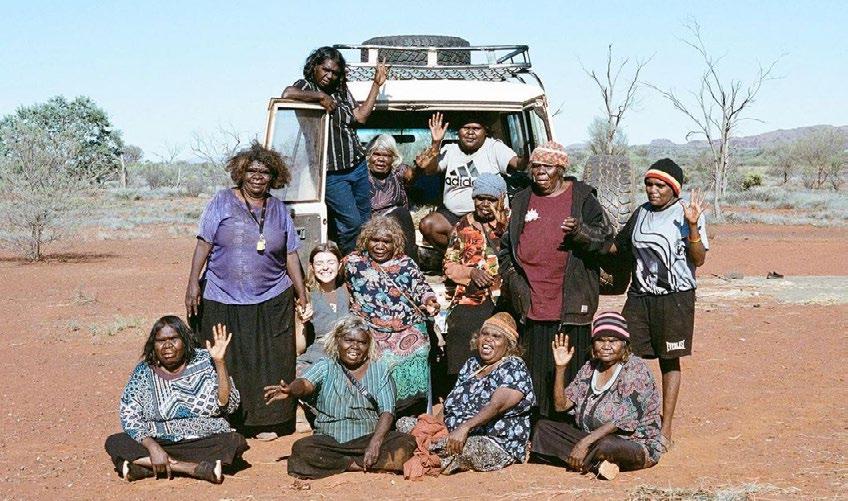
30
Papulankutja Artists
Papulankutja Artists on Country, 2022. Photograph by Beth Lewis, courtesy of Papulakutja Artists.
Papulankutja Artists painting at the Art Centre, 2022.
Photograph by Beth Lewis, courtesy of Papulakutja Artists.
Papulankutja Artists painting on Country, 2022.
Photograph by Beth Lewis, courtesy of Papulakutja Artists.
PAPULANKUTJA/BLACKSTONE AND MANTAMARU/JAMESON, WESTERN AUSTRALIA
Papulankutja Artists
“I paint the land as I look down on it, my Grandfather’s land. I am not painting that Tjukurrpa, that man’s story. I paint the land and the feelings I have when I’m on that Country.”
Artist Sharon Doolan
Papulankutja Artists is an Aboriginal owned not-for-profit corporation operating in Blackstone community, approximately 900 kilometres west of Alice Springs and 1,575 kilometres north-east of Perth. The art centre was originally a women’s centre, with painting encouraged as an activity for both women and men since the mid-1980s. As the Aboriginal art market expanded, it became necessary to establish a framework to protect the artists’ interests, and Papulankutja Artists was officially established in 2003. In 2009 Papulankutja
Artists moved into the purpose-built art centre which now extends services to artists in Mantamaru (Jameson) community, 75 kilometres to the west.
The art centre provides Ngaanyatjarra artists and other Anangu the space to express a sense of purpose through creative expression in the telling of Tjukurrpa (Dreamtime), support for the social connection and wellbeing of all members and a source of independent income for the artists and their families. The art centre supports visual art projects and production in various mediums including painting, tjanpi weaving, punu carving, and jewellery made from local nuts and seeds. Papulankutja Artists are also well-known for their soap production, a unique offering of remedial healing, filled with bush medicine from the Ngaanyatjarra Lands.
Nora Nyutjanka Davidson
Sharon Doolan
Janet Forbes
Angela Lyons
Angilyiya Mitchell
Jennifer Nginyaka Mitchell
31 Really One Story: Art from the Ngaanyatjarra Lands
This is the story of two powerful magicians who came to the Ngaanyatjarra Lands from far away to the west:
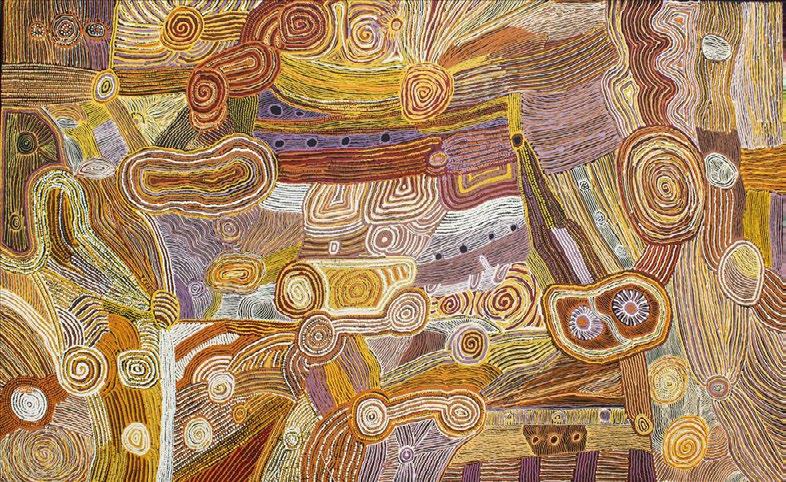
“These two men are always together, always camping together. They do all sorts of tricks when they travel across the lands as they stop from place to place. When they reached Wirtapi Wara (Long Black or Blackstone Range) they argued about which way to go around. One went around the south side and the other the north side.
At a distance it seemed they didn’t recognise each other or perhaps they were just pretending not to recognise each other! It is
also said that at Papulankutja they tricked each other by changing their appearance at the same time so they had no chance to recognise each other. The name Papulankutja comes from the Ngaanyatjarra word meaning, ‘to stare without recognising each other’.
They usually took the form of goanna but they could turn into other animals as well. Finally, when they got to Kaltukatjara (Docker River) they had become so arrogant that without realising they walked straight into some local men’s business even though they were warned by the local women. The goanna men led themselves blindly to their fate.”
32
Papulankutja Artists
Text courtesy of Papulankutja Artists
Janet Forbes
Wati Kutjarra, 2022
Acrylic on cotton canvas 61 x 101 cm EX-ROS-371-22
Kungkarrangkalpa (The Seven Sisters or Pleaides) is significant Tjukurrpa (dreaming). Its origins you may be familiar with in astronomy and its connection to Wati Nyiru (Magic Man or Orion). The roots of this dreaming stems across Indigenous groups around the world. The Australian Aboriginal songline is one part to the whole dreaming which can be traced all around the world. The ladies of the Ngaanyatjarra Lands depict their significant chapter and understanding of the journey of the sisters. The different versions of this story depend on where you live and the significances of local Tjukurrpa places.
Nyiru fell in love with the sisters but he was of the wrong skin group to marry, but he still pursued them on their journey. The sisters travel across the land to escape Nyiru’s unwanted attentions, but he is persistent and always finds them. There are significant land forms which can be sited today that evidence this dreaming. As Nyiru is chasing the sisters he tries to catch them by using magic… Eventually, the sisters fly into the sky to escape Nyiru, forming the Pleaides constellation. Nyiru felt lonely, longing for the sisters who were so far away. Nyiru used his magic to go to the sky, forever in pursuit.

33 Really One Story: Art from the Ngaanyatjarra Lands
Text courtesy of Papulankutja Artists
Angilyiya Mitchell
Kungkarrangkalpa (Seven Sisters), 2022
Acrylic on cotton canvas 61 x 101 cm EX-ROS-343-22
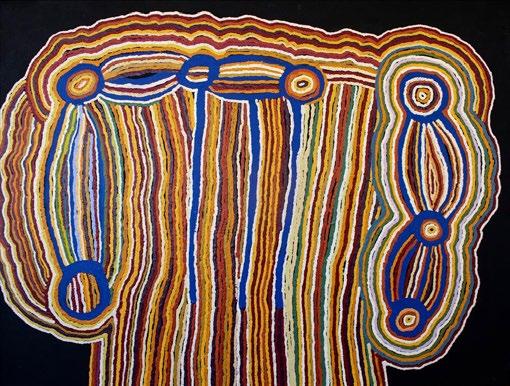
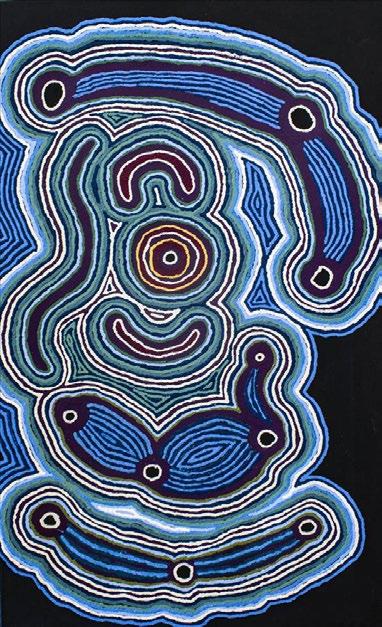

34 Papulankutja Artists
Jennifer Nginyaka Mitchell Untitled, 2022 Acrylic on cotton canvas 101 x 76 cm EX-ROS-188-22
Jennifer Nginyaka Mitchell Untitled, 2022 Acrylic on cotton canvas 92 x 122 cm EX-ROS-266-22
Jennifer Nginyaka Mitchell Kungkarrangkalpa (Seven Sisters), 2022 Acrylic on cotton canvas 61 x 101 cm EX-ROS-253-22
Nora Nyutjanka Davidson
Kapi Tjukurla
(Tjukurla Rock Holes), 2022
Acrylic on cotton canvas
92 x 92 cm
EX-ROS-278-22
Nora Nyutjanka Davidson
Kapi Tjukurla
(Tjukurla Rock Holes), 2022
Acrylic on cotton canvas

61 x 101 cm
EX-ROS-242-22

35 Really One Story: Art from the Ngaanyatjarra Lands
My Grandfather’s Country, 2022
Acrylic on cotton canvas
92 x 122 cm


EX-ROS-309-22
My Grandfather’s Country, 2022
Acrylic on cotton canvas
101 x 152 cm
EX-ROS-329-22
36 Papulankutja Artists
Sharon Doolan
Sharon Doolan

37 Really One Story: Art from the Ngaanyatjarra Lands
Angela Lyons Kungkarrangkalpa (Seven Sisters), 2022 Acrylic on cotton canvas 61 x 101 cm
EX-ROS-306-22




38
Tjanpi Desert Weavers
LR Miriam Iwana Lane, Claudia Yayimpi Lewis, Mildred Lyons, Jennifer Mintiyi Connolly, Elaine Warnatjura Lane, Angilyiya Tjapati Mitchell, Paula Sarkaway Lyons, Jennifer Nginyaka Mitchell, Mrs Davidson, Nora Nyutjanka Davidson, Janet Nyumitji Forbes, Freda Yimunya Lane. Kungkarrangkalnga-ya Parrpakanu (Seven Sisters Are Flying). 2015. Image by Vicki Bosisto. © Tjanpi Desert Weavers, NPY Women’s Council.
Dianne Ungukalpi Golding from Warakurna WA. 2019. Image by Rhett Hammerton. Courtesy of Koskela. © Tjanpi Desert Weavers, NPY Women’s Council.
Roma Butler from Irrunytju (WA) with her mingkiri (mouse). 2017. Image by Rhett Hammerton. © Tjanpi Desert Weavers, NPY Women’s Council.
Cynthia Burke from Warakurna (WA). 2019. Image by Rhett Hammerton. Courtesy of Koskela. © Tjanpi Desert Weavers, NPY Women’s Council.
NGAANYATJARRA PITJANTJATJARA YANKUNYTJATJARA LANDS
Tjanpi Desert Weavers
Tjanpi Desert Weavers is a social enterprise of the Ngaanyatjarra
Pitjantjatjara Yankunytjatjara (NPY)
Women’s Council, which works with women living across Australia’s remote Central and Western deserts. Tjanpi artists use native grasses to make spectacular contemporary fibre art, weaving baskets and sculptures that display endless creativity and inventiveness.
Tjanpi (‘grass’ in Pitjantjatjara language) represents over 400 artists from 26 remote communities spread across the NPY Lands, an area of approximately 350,000 square kilometres spanning the tri-state border region of the Northern Territory, Western Australia, and South Australia.
Tjanpi field officers regularly traverse this area to visit each community, purchasing artworks, supplying art materials, holding
skills development workshops, and facilitating grass-collecting. While out collecting grass, women are also able to spend time on Country and maintain their culture through gathering food, hunting, performing inma (cultural song and dance), and teaching their children.
The Tjanpi artists range from the senior women who first began making baskets and fibre sculptures in 1995, to younger generations who are taking up weaving today. Creating baskets and sculptures from tjanpi is today a fundamental part of Central and Western desert culture for these women, and the collective’s works have been exhibited and acquired nationally and internationally in recognition of their unique expression of desert life and culture.
Lynette Brown
Yanyangkari Roma Butler
Cynthia Burke
Loretta Carroll
Diane Dawson
Noreen Dawson
Linda Eddy
Sally Foster
Renae Fox
Tanisha Fox
Yangi Yangi Fox
Dianne Ungukalpi Golding
Stacia Yvonne Lewis
Lucy Nelson
Rene Nelson
Delilah Shepherd
Erica Ikungka Shorty
Cassie-Ann Woods
Elaine Woods
39 Really One Story: Art from the Ngaanyatjarra Lands


40 Tjanpi Desert Weavers
Dianne Ungukalpi Golding Pinirnpa (Ant Bed), 2023 Basket
D72 x H62 cm EX-ROS-1773-23
Yanyangkari Roma Butler Pinirnpa (Ant Bed), 2022 Basket
D65 x H51 cm EX-ROS-1683-23
Cynthia Burke
Pinirnpa (Ant Bed), 2023
Tjanpi (wild harvested grass), bush dyed raffia, bush dyed wool
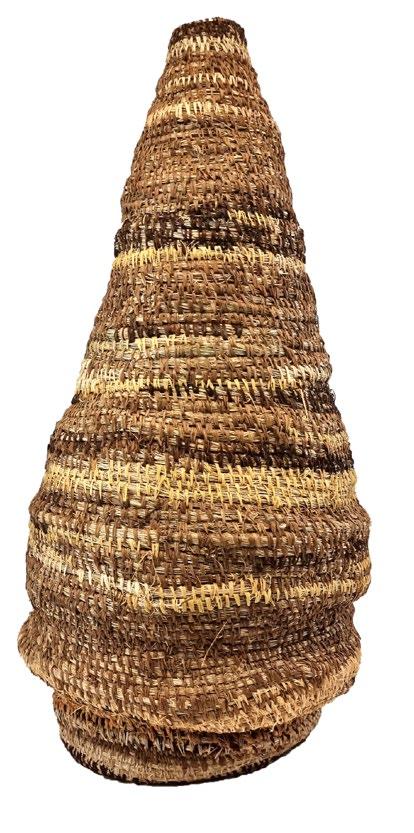
D43 x H91 cm
EX-ROS-1791-23
Created by three of the leading contemporary Tjanpi weavers, Pinirnpa (Ant Bed) honours the early days of fibre arts practice in the Ngaanyatjarra region, when mothers, aunties and grandmas of the artists began experimenting with coiled basketry and bush dyeing. These works tell a story of the quiet beauty of the expansive Ngaanyatjarra Country that is home, capturing the organic shapes and soft colours of the landscape through natural dying and manipulation of coiling technique. Native barks, leaves and tree roots were collected to hand-dye material incorporated into the artwork. The resulting gentle variations of colour capture the exquisite colours found across the artists’ homelands.
Paying homage to the pioneering fibre artists, Pinirnpa celebrates the intergenerational sharing of knowledge and skills, technique and form, interlaced with a deep and significant connection to Country and culture.
41 Really One Story: Art from the Ngaanyatjarra Lands
Kukaputju – The Hunter
Cultural Director and Storyteller: Yanyangkari Roma Butler
Director/Animator: Jonathon Daw
Executive Producer: Michelle Young (Tjanpi Desert Weavers)
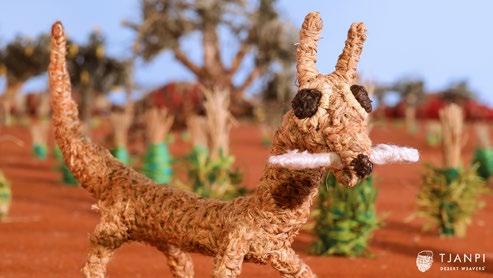

Creative Producer: Karen Riederer
Character Artists: Yanyangkari Roma Butler, Stacia Yvonne Lewis, Diane
Dawson, Yangi Yangi Fox, Rene Nelson, Lucy Nelson, Cassie-Ann Woods
Set & Prop Artists: Stacia Yvonne Lewis, Yangi Yangi Fox, Diane Dawson, Rene
Nelson, Lucy Nelson, Renae Fox, Cassie-Anne Woods, Tanisha Fox, Noreen
Dawson, Elaine Woods, Lynette Brown, Linda Eddy, Cynthia Burke, Delilah
Shepherd, Loretta Carroll, Sally Foster
Creative Development: Jade Brockley
Cultural Advisors: Cynthia Burke, Dalilah Shepherd
Subtitles & Translations: Beth
Sometimes, Nyunmiti Burton, Linda Rive
Camera: Jonathon Daw (animation), Anna Cadden (live action)

Sound Design: Jeremy Conlon
Credits: Amber Stacey
Advisor: Kate Cawley (RMIT University)
42 Tjanpi Desert Weavers Tjanpi Desert Weavers Kukaputju - The Hunter 2021 05:48 minutes Animation
Kukaputju – The Hunter is a short film produced by Tjanpi Desert Weavers. It combines the art forms of Tjanpi fibre sculpture, stop-motion animation and oral storytelling to bring to the screen a proud episode in the everyday life of the Anangu woman whose story this is: Yanyangkari Roma Butler. In her first language of Pitjantjatjara, Yanyangkari gives a beautifully expressive account of a day like many others when she decided to go hunting in the bush, near the tri-state border of Western Australia, South Australia and the Northern Territory.
The work was conceived and created by Yanyangkari and 16 other Tjanpi artists from the region, using tjanpi (desert grasses) – primarily native minarri (greybeard grass) gathered by Tjanpi artists on their country. The grasses
were wrapped around wire armatures, and stitched with raffia. The handmade ethos of both tjanpi and stop-motion animation was carefully maintained, with almost everything on screen handmade from natural fibres, and all animation created in-camera.
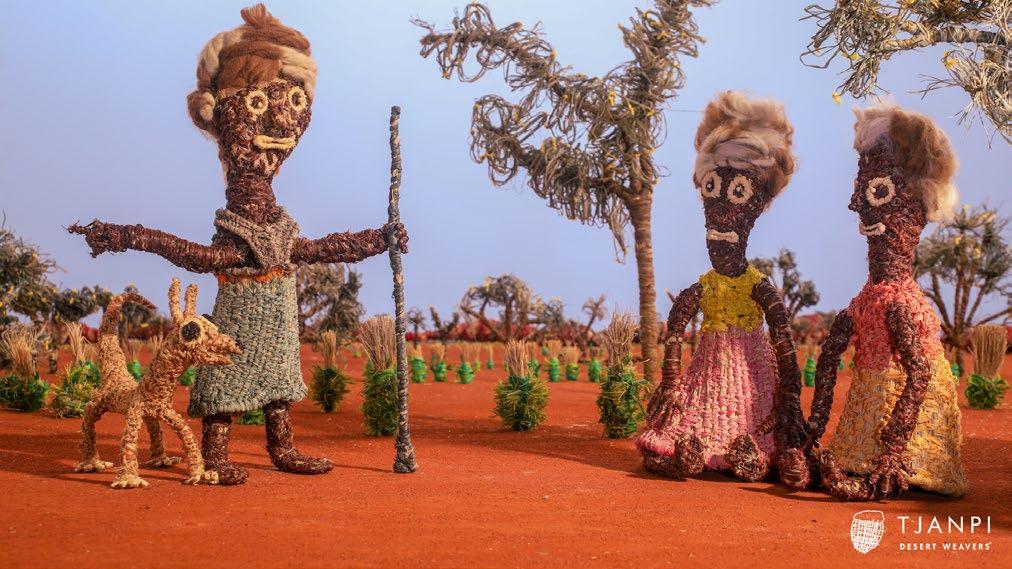
Kukaputju arose from Tjanpi’s artist-led imperative to explore different ways to tell and share Anangu stories through Tjanpi artwork. Tjanpi’s first animation ventures, Ngayuku
Papa: Tiny and Ngayuku Papa: Bluey and Big Boy (2018), had proven that animation is an exceptional storytelling medium for the tactile form and inherent whimsy of Tjanpi fibre sculptures.
This film was supported by the Australian Government’s Indigenous Languages and the Arts program.
43 Really One
the Ngaanyatjarra Lands
Story: Art from
Erica Ikungka Shorty
Pussy Cat, 2023
Sculpture
L47cm x W17cm x H29cm
EX-ROS-1718-23
Erica Ikungka Shorty
Pussy Cat, 2023
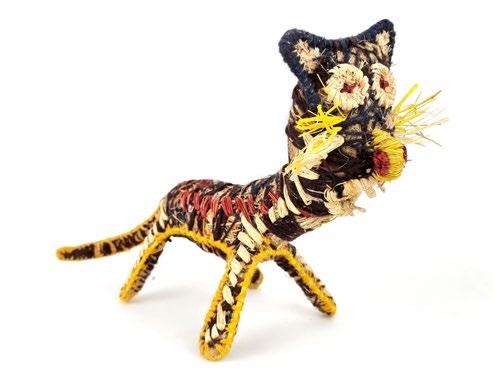

Sculpture
L57cm x W17cm x H21cm
EX-ROS-1717-23
44 Tjanpi Desert Weavers
 Green tjanpi grass drying in the sun near Warakurna, WA. 2022. Image by Jade Brockley. © Tjanpi Desert Weavers, NPY Women’s Council.
Green tjanpi grass drying in the sun near Warakurna, WA. 2022. Image by Jade Brockley. © Tjanpi Desert Weavers, NPY Women’s Council.


46 Tjanpi Desert Weavers
Katjarra Butler, Sally Butler, May Gibson, Faith Butler, Kenisha Gibson, Jade Butler and Bob Gibson painting at Tjarlirli Art, 2022. Photograph courtesy of Tjarlirli Art.
Tjarlirli art centre in Tjukurla, 2022.
Photograph courtesy of Tjarlirli Art.
Tjarlirli Art
“We work in Tjukurla. We’re always painting here in Tjukurla. This is my home. This is where I am.”
Artist Faith Butler
Tjarlirli Art is an Aboriginal-owned and controlled not-for-profit art, cultural, and community organisation established in 2006, which represents the artists of Tjukurla in the Ngaanyatjarra Lands of Western Australia, and Kaltukatjara in the Pitjantjatjara Lands of the Northern Territory. Tjarlirli Art’s core business is the preservation, maintenance and promotion of the artwork of the Ngaanyatjarra people by nurturing the development of traditional and contemporary artistic
practice, exploring new mediums and innovative opportunities for creative expression. As the primary business venture in Tjukurla, the art centre provides much-needed income and employment in this remote community of approximately 40 people.
The artwork produced by artists at Tjarlirli Art has strong links with the Papunya Tula movement of the mid-1980s, when families left Walungurru (Kintore) and Kiwirrkurra to return to their homelands. Today Tjarlirli’s art centres are hubs of creativity and vital community services, with the artists’ works represented in major national and international collections.
Faith Butler
Katjarra Butler
Bonnie Connelly
Bob Gibson
Jillian Giles
Winsome Newberry
Elsa Fiona Young
47 Really One Story: Art from the Ngaanyatjarra Lands
TJUKURLA, WESTERN AUSTRALIA
Korrmankuntja directly means ‘thunder is happening there’, though for the Country and the actions of the Tjukurrpa creation, it is more accurately known as ‘a place of thunder’. This place is very important for Katjarra. She was born at this very site and received her Tjukurrpa here. She has the strongest connection to this place though Pintupi/Ngaanyatjarra customs.
At Korrmankuntja, when Katjarra’s mother was pregnant with her, a python (Kuniya) appeared in front of her. Katjarra’s mother killed the snake, and Kuniya became Katjarra. Katjarra’s mother believed that that very python was symbolic of the dreaming python from this area.
Kuniya, the creation python, travelled to Korrmankuntja, where the thunder instructed Kuniya to continue onwards to Patjantja, but with a warning.
Korrmankuntja, 2022
91 x 122 cm
EX-ROS-22-723

48
Text courtesy of Tjarlirli Art.
Tjanpi
Desert Weavers
Katjarra Butler
Acrylic on canvas
Bob enjoys telling the stories from his father’s Country around Patjarr and his mother’s Country Kulkurta. This work is about two snakes and two men who travelled north to Karrkurinkitja. As the party travelled, some strangers came up behind them and the snakes fled. Then Kurningka (boss of the Tingari men) went looking. The clouds were coming towards them. The snakes were travelling fast and the water was rising, and the lady snake went in the ant’s hole but the other snake was left outside. Kurningka was saying, ‘water is coming closer’ but the other snake was too big for the hole. The Kurningka cut the snake and a lot of fat came out.

49 Really One Story: Art from the Ngaanyatjarra Lands
Text courtesy of Tjarlirli Art.
Bob Gibson
Patjantja, 2022
Acrylic on canvas
122 x 152 cm
EX-ROS-22-782KA
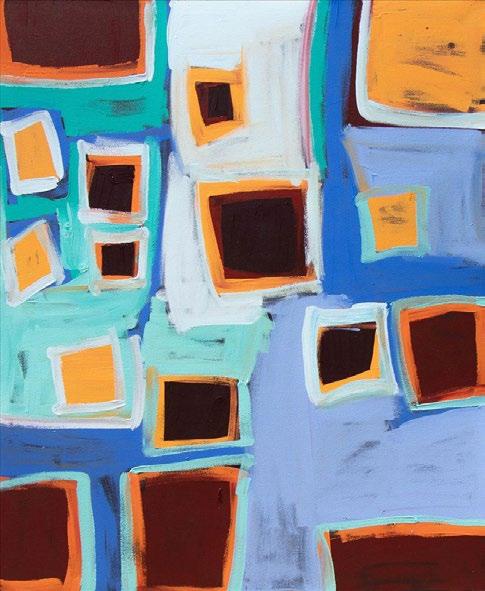
50 Tjanpi Desert Weavers
Bob Gibson Patjantja, 2022 Acrylic on canvas 122 x 147 cm EX-ROS-22-781KA

51 Really One Story: Art from the Ngaanyatjarra Lands
Bob Gibson Patjantja, 2022 Acrylic on canvas 122 x 147 cm EX-ROS-22-142
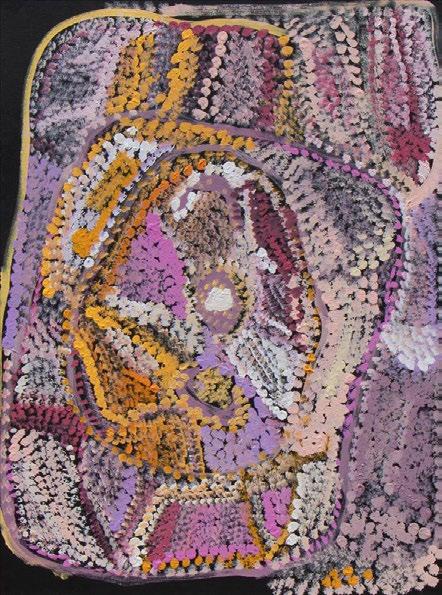
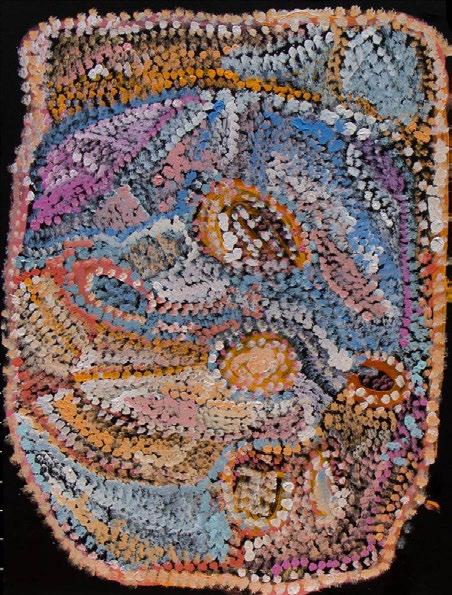
52 Tjanpi Desert Weavers
Bonnie Connelly Minyma Kutjara, 2022 Acrylic on canvas 76 x 102 cm EX-ROS-22-929KA
Bonnie Connelly Ngurra Tjalaku, 2022 Acrylic on Canvas 76 x 102 cm EX-ROS-22-890KA


53 Really One Story: Art from the Ngaanyatjarra Lands
Elsa Fiona Young Minyma , 2022
Acrylic on canvas 122 x 147 cm
EX-ROS-22-240
Elsa Fiona Young Minyma, 2022
Acrylic on canvas 122 x 147 cm
EX-ROS-22-831
Kurlkurta Faith, 2022
Acrylic on canvas
122 x 147 cm
EX-ROS-22-386
Kurlkurta, 2022
Acrylic on canvas
91 x 122 cm

EX-ROS-22-724

54 Tjanpi Desert Weavers
Faith Butler
Faith Butler


55 Really One Story: Art from the Ngaanyatjarra Lands
Faith Butler Inma (ceremony) at Kurlkurta, 2022
Acrylic on canvas
76 x 102 cm
EX-ROS-22-823
Jillian Giles
Minyma Tjukurla, 2022
Acrylic on canvas 147 x 178 cm
EX-ROS-21-534
Katjarra Butler
Papuun, 2022
Acrylic on canvas
91 x 122 cm
EX-ROS-22-725
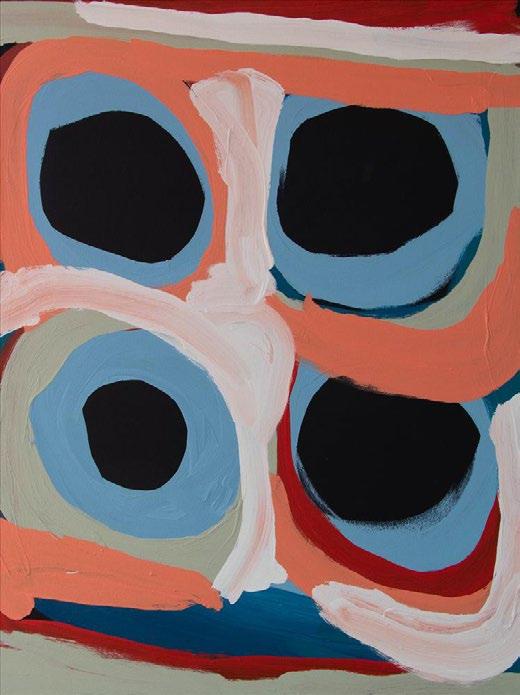
56 Tjanpi Desert Weavers

57 Really One Story: Art from the Ngaanyatjarra Lands
Winsome Newberry
Kapi Tjukurrpa, 2022
Acrylic on canvas
91 x 122 cm
EX-ROS-22-1067KA



58 Warakurna Artists
Nyungawarra Ward and Nancy Nyanyarna Jackson making damper in Patjarr. ©Courtesy of Warakurna Artists.
Nyungawarra Ward painting in the Warakurna studio. Photograph coutesy of Warakurna Artists.
Reggie Smith and George Ward painting at Wanarn Age Care. Photograph coutesy of Warakurna Artists.
Warakurna Artists
“I like to paint my story, my grandfather’s, my grandmother’s… I think about these stories and my family when I am painting. Proper story. Painting keeps my family, and these stories close to me.”
Artist Nyungawarra Ward
Warakurna is a remote community situated on the Great Central Road in the Ngaanyatjarra Lands of Western Australia, approximately 330 kilometres from Uluru, near the border with the Northern Territory. The township of about 180 people is nestled amongst the spectacular Rawlinson Ranges in the Gibson Desert, close to the Giles Meteorological Weather Station.
Warakurna has a well-established history of artistic expression. The art centre studio, which opened in 2005, is fully owned and governed by Aboriginal people, providing services to artists living in and visiting Warakurna, as well as to those in the neighbouring community of Wanarn through the Painting Therapy Program at Wanarn Aged Care. In 2015, Warakurna Artists merged operations with the Kayili Artists of Patjarr, enabling artists to continue their art practice while remaining on Country. Warakurna Artists travels regularly to Patjarr to provide this vital cultural maintenance program.
Ruth Bates
Dorcas Tinamayi Bennett
Cynthia Burke
Roma Butler
Nancy Tjungupi Carnegie
Nancy Nyanyarna Jackson
George Ward Tjungurrayi
Nyungawarra Ward
59 Really One Story: Art from the Ngaanyatjarra Lands
WARAKURNA, WANARN AND PATJARR, WESTERN AUSTRALIA
Mr Ward’s works can be read as visual histories, as well as maps of his Country. This painting depicts the Tjukurrpa story about the tingarri men, women and children traveling from rock hole to rock hole. The tingarri people travelled north through Wirrintjunku, Pukaritjarra, Tarkal, Nyun and Kirritji as they move toward Tjukurla.
George Ward Tjungurrayi
Tingarri, 2022
Acrylic on linen
76 x 150 cm
EX-ROS-256-22
The Tingarri Song Cycle depicts the route of dreamtime people who travelled from the sea near Port Hedland to the northern part of the central desert. It also refers to the route and to the dreamtime people who followed that route.

60
Warakurna Artists
Text courtesy of Warakurna Artists
Nyungawarra Ward
Patjarr, 2022
Acrylic on canvas
76 x 150 cm EX-ROS-328-22
“I am painting Yankuntjuntju. It is my grandmother’s country, close to Patjarr. There’s a rockhole close. I like to paint my story, my grandfather’s, my grandmother’s. My father’s mother passed away at that rockhole, that is why I’m painting. My grandmother had two sons, two daughters. [She] passed away right
there, rockhole side. I also paint Karrku, that’s my nyal-ku Tjukurrpa, (my dreaming) Porcupine dreaming in that place. I think about these stories and my family when I am painting. Proper story. Painting keeps my family, and these stories close to me.“
Artist Nyungawarra Ward

61 Really One Story: Art from the Ngaanyatjarra Lands

62 Warakurna Artists
Nancy Nyanyarna Jackson Tali, 2022
Acrylic on linen
76 x 150 cm
EX-ROS-254-22
Yunpalara, 2022
Acrylic on canvas
122 x 152 cm
EX-ROS-365-22
Yunpalara, 2022
Acrylic on canvas
122 x 152 cm

EX-ROS-366-22
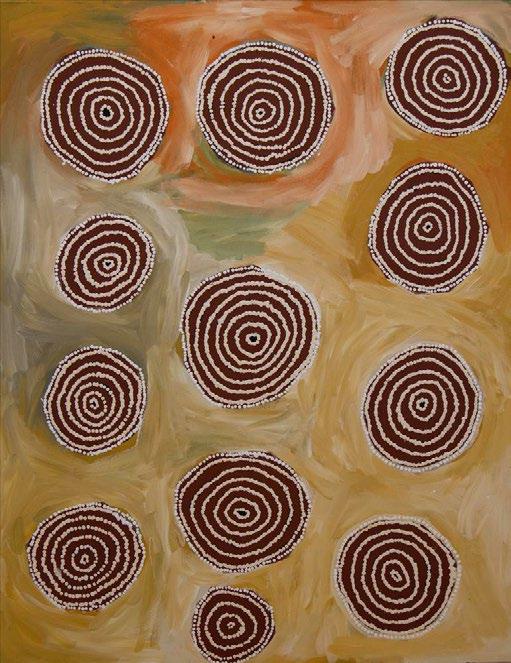
63 Really One
Art
the Ngaanyatjarra Lands
Story:
from
Nancy Tjungupi Carnegie
Nancy Tjungupi Carnegie
Landscape - Warakurna, 2022
Acrylic on canvas
76 x 150 cm
EX-ROS-332-22
Landscape - Warakurna, 2022
Acrylic on canvas
76 x 150 cm

EX-ROS-420-22

64 Warakurna Artists
Cynthia Burke
Cynthia Burke
Minyma Kutjarra at Docker River, 2022
Acrylic on canvas
76 x 150 cm
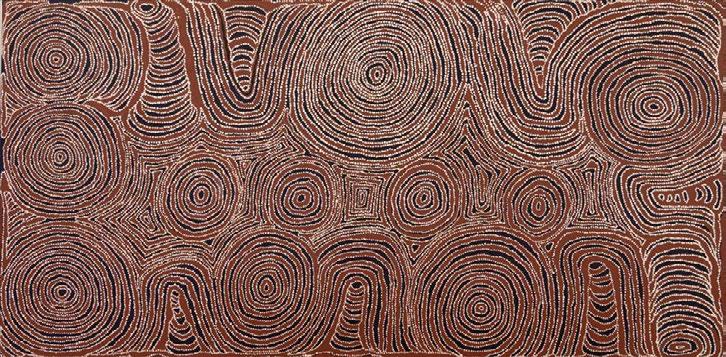
EX-ROS-333-22
Minyma Kutjarra at Docker River, 2022
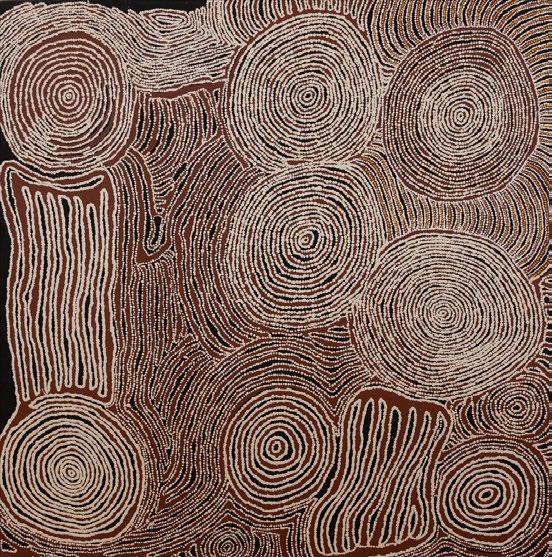
Acrylic on linen
101 x 101 cm
EX-ROS-334-22
65 Really One Story: Art from the Ngaanyatjarra Lands
Roma Butler
Roma Butler
Acrylic on linen
152 x 152 cm
EX-ROS-421-22

66 Warakurna Artists
Dorcas Tinamayi Bennett Mother’s Story, 2022

67 Really One Story: Art from the Ngaanyatjarra Lands
Ruth Bates
Patjarr Creek, 2022
Acrylic on canvas
76 x 150 cm
EX-ROS-396-22
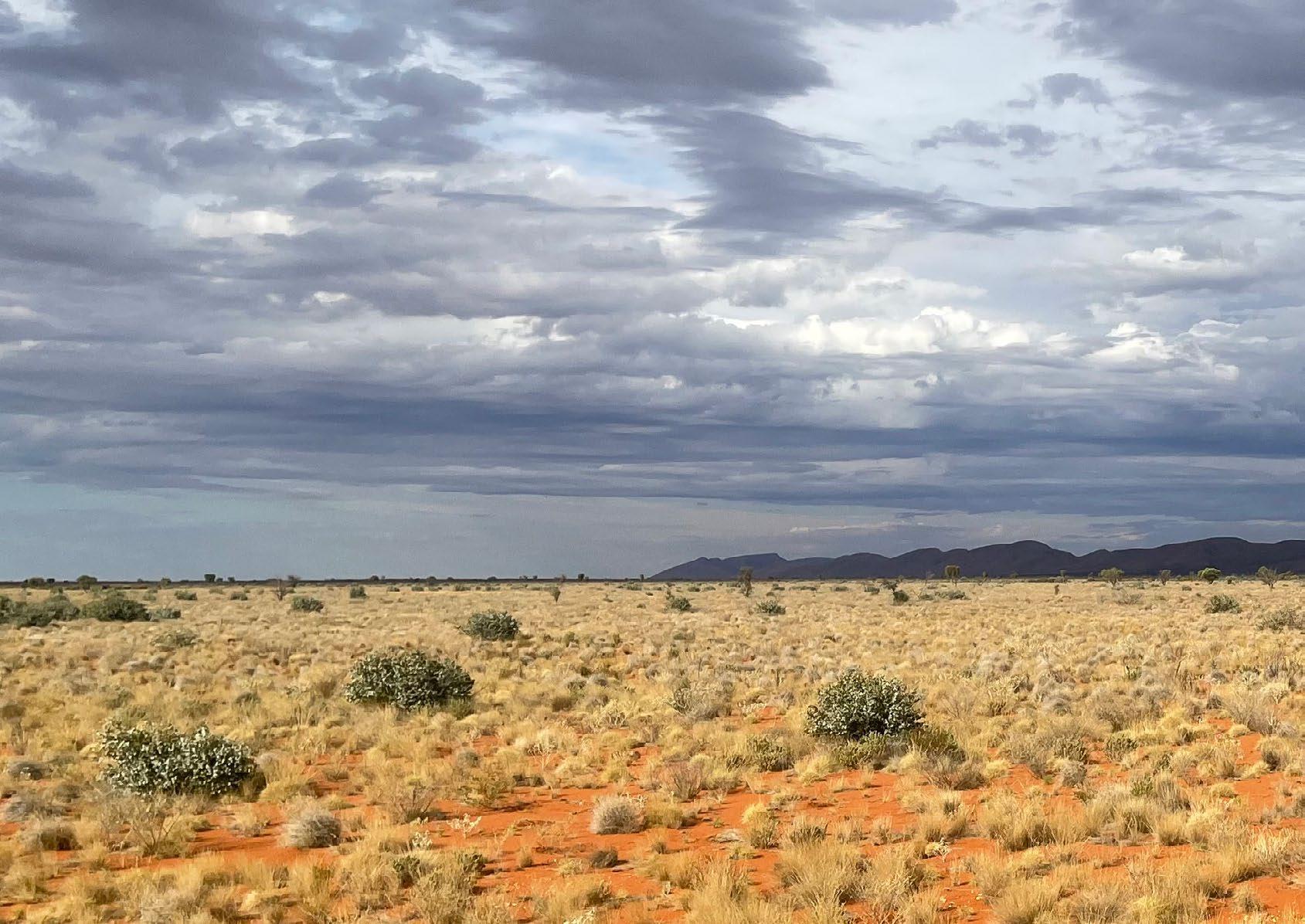 Tjanpi grass fields near Warakurna, WA, 2022. Image by Jade Brockley. © Tjanpi Desert Weavers, NPY Women’s Council.
Tjanpi grass fields near Warakurna, WA, 2022. Image by Jade Brockley. © Tjanpi Desert Weavers, NPY Women’s Council.

Acknowledgements
FORM would like to thank the participating art centres for their involvement in this project.
FORM Building a State of Creativity Inc.
39 Gugeri Street
Claremont, Western Australia, 6010
FORM Gallery
4 Shenton Road, Claremont, Western Australia, 6010
mail@form.net.au
+ 61 8 9385 2200
Really One Story: Art of the Ngaanyatjarra Lands was published by FORM Building a State of Creativity Inc in March, 2023, to accompany the exhibition of the same name at FORM Gallery.
Curated by Andrew Nicholls with the participating art centres
Project managed by Emma Poletti
Project coordination by Emily Coy and Steph Semler
Catalogue text by Andrew Nicholls and Mags Webster
Edited by Emma Poletti
Catalogue designed by Valery Emelianova
© 2023. All right reserved. Copyright for the photographic images is held by the individual photographers and art centres. Copyright for written content and this publication is held by FORM and the participating authors.
www.form.net.au
71 Really
One Story: Art from the Ngaanyatjarra Lands
Gallery Partner Government Partners
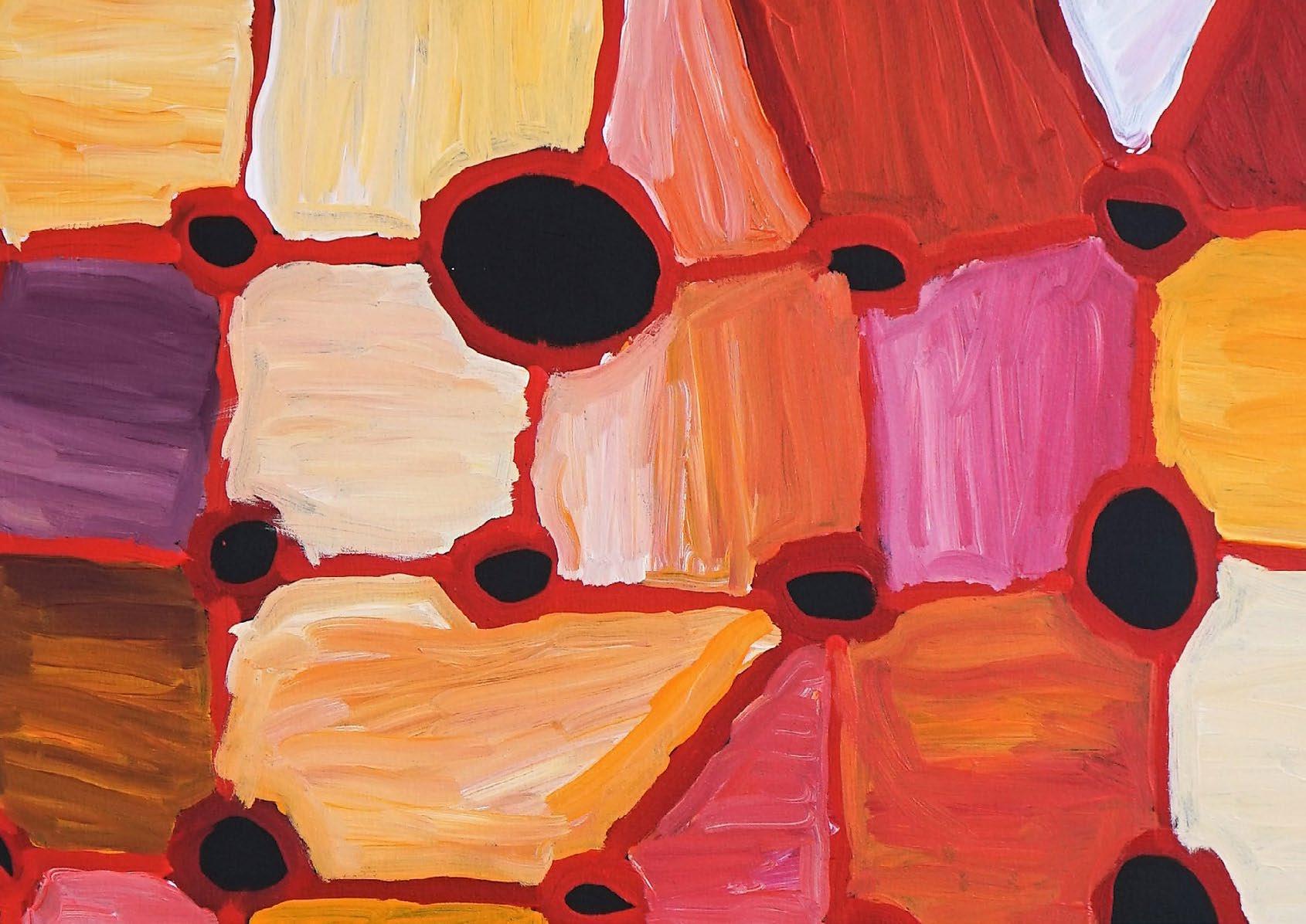

 Country near Tjukurla. Photograph courtesy of Tjarlirli Art.
Country near Tjukurla. Photograph courtesy of Tjarlirli Art.





 Really One Story exhibition opening, FORM Gallery, 2023. Photograph by Dan MacBride, courtesy of FORM.
Really One Story exhibition opening, FORM Gallery, 2023. Photograph by Dan MacBride, courtesy of FORM.
 Tinkas by Cynthia Burke, 2022.
Photograph courtesy of Maraku Arts and FORM.
Tinkas by Cynthia Burke, 2022.
Photograph courtesy of Maraku Arts and FORM.



























 Artist
Artist


























 Green tjanpi grass drying in the sun near Warakurna, WA. 2022. Image by Jade Brockley. © Tjanpi Desert Weavers, NPY Women’s Council.
Green tjanpi grass drying in the sun near Warakurna, WA. 2022. Image by Jade Brockley. © Tjanpi Desert Weavers, NPY Women’s Council.






























 Tjanpi grass fields near Warakurna, WA, 2022. Image by Jade Brockley. © Tjanpi Desert Weavers, NPY Women’s Council.
Tjanpi grass fields near Warakurna, WA, 2022. Image by Jade Brockley. © Tjanpi Desert Weavers, NPY Women’s Council.

